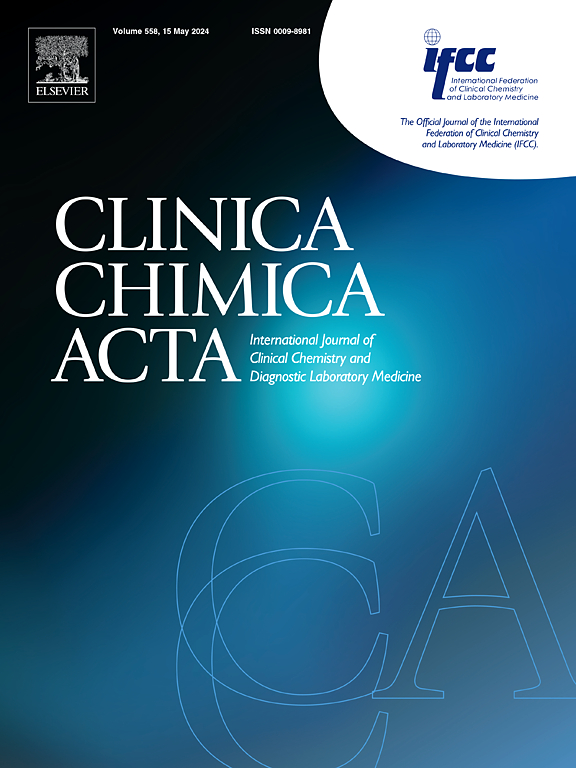Intra- and inter-day variations in oral metabolites from mouth-rinsed water determined using capillary electrophoresis–mass spectrometry metabolomics
IF 3.2
3区 医学
Q2 MEDICAL LABORATORY TECHNOLOGY
引用次数: 0
Abstract
Background and aims
Collecting clinical samples without inconveniencing participants is desirable. The profile of metabolites in mouth-rinsed water is similar to that in saliva. However, the intra- and inter-day variations in unstimulated or stimulated saliva metabolites from mouth-rinsed water have yet to be clarified. Thus, we aimed to fill this research gap using capillary electrophoresis–mass spectrometry metabolomics.
Materials and methods
We collected mouth-rinsed water from 15 healthy participants at 9:00, 11:30, 14:00, and 16:30 daily for 3 days. In total, 509 metabolite concentrations from 180 samples were obtained using capillary electrophoresis time-of-flight mass spectrometry. Variations in each metabolite were evaluated using the Wilcoxon signed-rank test to determine at which time/day significant differences occurred after removing metabolites without significant changes using the Friedman test.
Results
Of 167 frequently detected metabolites, 100 exhibited intra-day variations, and none exhibited inter-day variations. Intra-day variations were classified into four patterns, and the intra-day variation in each metabolite was assessed. The variations may reflect elapsed time after meals, oral cleaning, or circadian rhythms.
Conclusion
This study could serve as a reference for improving the design of future clinical trials and the accuracy of metabolome analysis of mouth-rinsed water samples collected at different dates and times.
利用毛细管电泳-质谱代谢组学测定漱口水中口腔代谢物的日内和日间变化。
背景和目的:在不给参与者带来不便的情况下采集临床样本是可取的。漱口水中的代谢物与唾液中的代谢物相似。然而,漱口水中未受刺激或受刺激的唾液代谢物在日内和日间的变化尚未明确。因此,我们希望利用毛细管电泳-质谱代谢组学来填补这一研究空白:我们收集了 15 名健康参与者的漱口水,时间分别为每天 9:00、11:30、14:00 和 16:30,为期 3 天。使用毛细管电泳飞行时间质谱法从 180 份样本中获得了 509 种代谢物的浓度。在使用弗里德曼检验去除无显著变化的代谢物后,使用 Wilcoxon 符号秩检验对每种代谢物的变化进行评估,以确定在哪个时间/天出现显著差异:结果:在 167 种经常检测到的代谢物中,有 100 种出现了日内变化,没有一种出现日间变化。日内变化分为四种模式,并对每种代谢物的日内变化进行了评估。这些变化可能反映了餐后时间、口腔清洁或昼夜节律:本研究可作为参考,用于改进未来临床试验的设计,并提高在不同日期和时间采集的漱口水样本代谢组分析的准确性。
本文章由计算机程序翻译,如有差异,请以英文原文为准。
求助全文
约1分钟内获得全文
求助全文
来源期刊

Clinica Chimica Acta
医学-医学实验技术
CiteScore
10.10
自引率
2.00%
发文量
1268
审稿时长
23 days
期刊介绍:
The Official Journal of the International Federation of Clinical Chemistry and Laboratory Medicine (IFCC)
Clinica Chimica Acta is a high-quality journal which publishes original Research Communications in the field of clinical chemistry and laboratory medicine, defined as the diagnostic application of chemistry, biochemistry, immunochemistry, biochemical aspects of hematology, toxicology, and molecular biology to the study of human disease in body fluids and cells.
The objective of the journal is to publish novel information leading to a better understanding of biological mechanisms of human diseases, their prevention, diagnosis, and patient management. Reports of an applied clinical character are also welcome. Papers concerned with normal metabolic processes or with constituents of normal cells or body fluids, such as reports of experimental or clinical studies in animals, are only considered when they are clearly and directly relevant to human disease. Evaluation of commercial products have a low priority for publication, unless they are novel or represent a technological breakthrough. Studies dealing with effects of drugs and natural products and studies dealing with the redox status in various diseases are not within the journal''s scope. Development and evaluation of novel analytical methodologies where applicable to diagnostic clinical chemistry and laboratory medicine, including point-of-care testing, and topics on laboratory management and informatics will also be considered. Studies focused on emerging diagnostic technologies and (big) data analysis procedures including digitalization, mobile Health, and artificial Intelligence applied to Laboratory Medicine are also of interest.
 求助内容:
求助内容: 应助结果提醒方式:
应助结果提醒方式:


